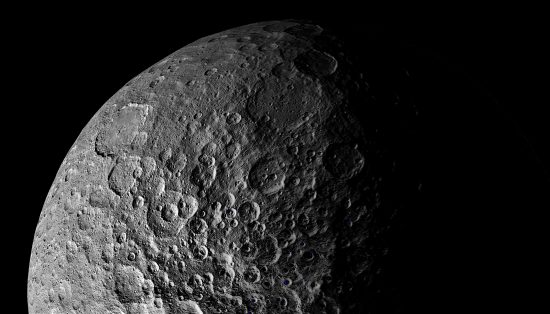
Areas of suspected “eternal shade” on Ceres. Credits: NASA/JPL-Caltech/UCLA/MPS/DLR/IDA. Click to enlarge.
Dec 21, 2017
Is there water ice on Ceres?
The dwarf planet Ceres adds weight to an electrical theory of the Solar System long proposed by Electric Universe advocates. Formations on moons and planets conform to that theory far better than they do to conventional ideas.
On September 27, 2007 NASA launched the Dawn spacecraft on a voyage to the asteroid Vesta. Scientific observations began on July 17, 2011 and then came to an end on September 5, 2012. Dawn then fired-up its ion thruster engine and headed toward Ceres. Dawn entered the gravity field of Ceres at a distance of 61,000 kilometers at 7:39 AM EST on Friday, March 6, 2015 where it continues in orbit.
Images of Ceres reveal a barren wasteland of a world: craters out of proportion to the dwarf planet’s size; deep trenches carved into its body; weird mountains; and bright material underneath a scorched and blasted surface. Ceres shares its pock-marked visage with other Solar System objects: the aforementioned Vesta, its sister dwarf planet in the asteroid belt, is a smaller fraternal twin of Ceres, with comparable formations.
Larger planetary bodies also resemble Ceres. Mercury, for example. One of the shared features on Mercury is large craters with fractures and furrows running through them. The etched furrows radiating outward from some craters denote untold numbers of electric filaments. On Earth, those filaments would have been the largest lightning strikes ever witnessed.
Dr. Cj Ransom created similar formations by exposing a thin layer of magnesium silicate to a 120 milliamp, 12,000 volt discharge for five seconds. He created radial gouges on a small scale equivalent to Mercury (and Ceres) at the large scale. Nobel Laureate Hannes Alfvén thought that electrical phenomena are scaleable by as much as 14 orders of magnitude.
According to a recent press release, there could be regions of permanent shadow on Ceres that might host deposits of water ice. This idea builds on theories about Mercury and the Moon. It is thought that there are craters on both bodies that contain water ice, although there is some dispute about the matter. NASA engineers crashed the Prospector spacecraft into the Moon, hoping to generate a cloud of dust and water ice, but no such cloud was detected. Evidence for ice-in-shadow on Mercury is only indirect.
Planetary scientists think that water ice exists on Ceres because it is supposed to have changed its axial tilt many times over the eons. Analyzing a computer model of the changes in its obliquity suggests that some craters might never see the Sun. They admit, however, that the origin of the ice on Ceres “is more mysterious”.
Problems with modeling a billion year history notwithstanding, Ceres exhibits what can best be described as a violent past. Whether that past was recent in the history of the Solar System, or more remote in time is not important. From an Electric Universe perspective, what is important is the reason why Ceres (and Mercury and the Moon) appears to be so devastated.
Most large craters on Ceres are electrical in nature. They can be recognized by their steep sides, sharp rims, flat floors, and a lack of blast debris inside the craters or strewn around them. Geshtin crater is 77 kilometers across, with 60 kilometer Datan crater on its rim, creating another crater wall inside Geshtin. Datan, according to NASA scientists, was then hit on its rim. Since more then 50% of the craters on Ceres have other craters on their rims, chance impacts from meteors is an intellectual stretch.
When electricity passes over a solid body the current pulls charged material from the contact surface. Neutral dust and stones are pulled along with ionized particles. Craters formed by electric arcs are circular because electromagnetic forces cause the arc discharge to maintain right angles. Since two or more filaments rotate around an arc axis, its secondary discharge can excavate steep side walls. If the surface is negatively charged, an arc will travel, and might jump from high point to high point. Smaller craters on the rims of larger ones reveal this phenomenon. A series of craters in a line, otherwise called a “crater chain”, is another sign of arcing to a negatively charged substrate.
June 2016 marked the official end of Dawn’s mission. It will not land on Ceres as the NEAR-Shoemaker satellite landed on Eros, but will continue circling Ceres for a minimum of 50 years, protecting the environment in case the putative water discovery is true. If water ice is there, it is most likely not due to forces that are gravitational in nature, and not because of accumulation over billions of years.
Stephen Smith












